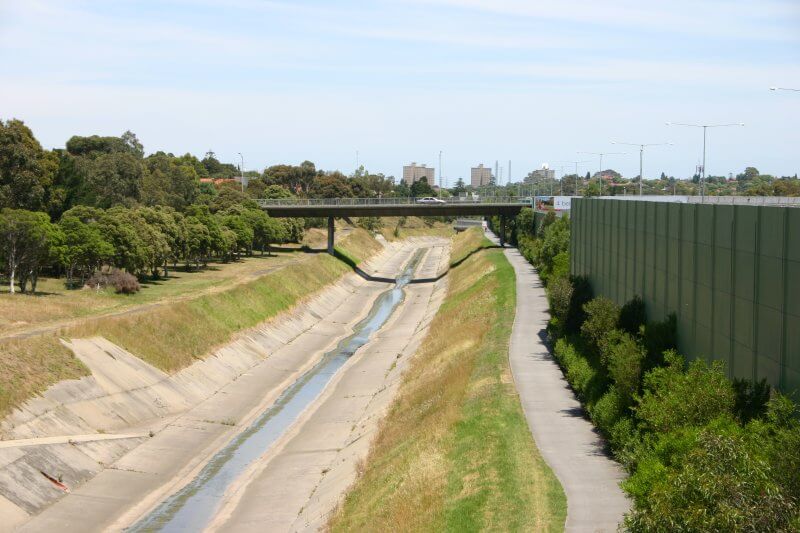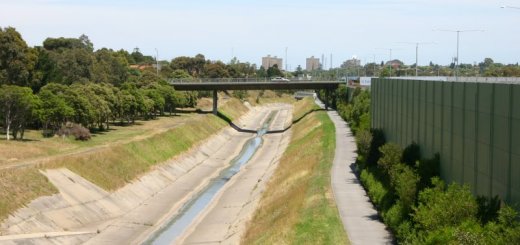Melbourne’s Moonee Ponds Creek is currently undergoing a significant transformation involving the removal of its concrete lining, planting of native trees, and creation of shared paths. However, preliminary investigations of the project in 2021 revealed challenges, including the presence of low levels of PFAS beneath the creek’s concrete base and fragments of non-friable asbestos in the soil. These environmental concerns have influenced decisions regarding the project’s execution.
The 360-metre section of the concrete-lined Moonee Ponds Creek is being redesigned to provide a more natural and community-friendly space. The transformation involves removing the concrete walls on both sides of the creek and replacing them with rockwork. Additionally, the concrete base of the channel will be covered with rockwork, aiming to form a winding creek that will decelerate water flow and offer a more natural appearance. The project also includes the planting of 43,000 native trees and shrubs. In terms of infrastructure developments, new shared paths, a bridge, and a pond near Oak Park Reserve are part of the plan.
Several benefits are anticipated from these re-naturalisation efforts. The modifications are expected to offer a more inviting creek-side setting where individuals can connect with nature in a healthier environment. Water quality is projected to improve, partly due to the reduced water flows. The area is also likely to witness enhanced biodiversity, providing a habitat for native species. Finally, the local community can look forward to better active transport connections and increased recreational opportunities in the area.
To ensure the safety of the transformation, comprehensive flood modelling has been carried out. The intention behind this is to ensure that the project does not escalate the flooding risk to either the local community or downstream users.
Historically, between the 1940s and 1980s, the Moonee Ponds Creek underwent significant alterations. The creek, spanning from Strathmore to Flemington Road, was extensively modified by the Melbourne and Metropolitan Board of Works (MMBW). The objective behind these changes was to efficiently redirect floodwater away from properties.
Over the years, perspectives on waterway management and drainage have evolved, now placing a higher emphasis on the environmental and social significance of natural waterways. Current strategies lean more towards restoring previously engineered stormwater channels to their natural states.
The “Reimagining Moonee Ponds Creek” project focuses on the creek’s northernmost concreted section, located in Oak Park and Strathmore. Feedback from the community highlighted this section as a priority. However, a significant challenge in naturalising large concrete channels, such as Moonee Ponds Creek, is the associated high cost.

Moonee Ponds Creek at West Brunswick looking south. Photo taken from the Hope Street pedestrian overpass. Moonee Ponds Creek Trail on the west bank next to the Tullamarine Freeway. Photo by www.takver.com and released under GNU FDLThe discovery of PFAS and non-friable asbestos fragments has posed additional challenges. The presence of PFAS led to the decision to retain the concrete base to contain the chemical. Instead, rockwork will be installed atop the concrete base. PFAS, or per-and polyfluoroalkyl substances, are a category of manufactured chemicals. Although everyday exposure to PFAS is common and generally in low quantities, there are still uncertainties regarding its impact on human health.
The removed concrete will be processed at a recycling facility, undergoing ‘thermal desorption’ to eliminate the PFAS. Once treated, the concrete can be repurposed for other projects.
A long-term strategic plan has been set by the Chain of Ponds Collaboration Group. Their vision is to gradually transform Moonee Ponds Creek into a signature waterway for Melbourne. Should the Reimagining Moonee Ponds Creek project prove successful and garner robust community support, it could potentially secure funding for naturalising other sections of the creek in the future.
Adhering to contamination handling guidelines regarding the presence of non-friable asbestos fragments in the soil, a licensed contractor will manage the removal, ensuring minimal risk. Additionally, Melbourne Water plans to monitor air quality in the area as an extra safety measure.








